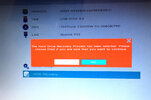This unmodified, fully-updated Windows 10 laptop has behaved pretty normally up to now, and is out of its extended guarantee period. But suddenly when I switch on all I get is the "Toshiba - Leading Innovation" splash screen, followed after a while by "Preparing Automatic Repair" and the spinning dots underneath this logo. For ever, and ever and ever.... or until the battery runs out if it is not plugged in.
Of course there is no longer any support from Toshiba who pulled out of the market - as did Sony earlier just when I needed them. I have searched in vain for a local repair service - I am sure there used to be dozens, but even "Checkatrade" has no entries for PC fixers any more. Googling gets me dozens of different YouTube etc solutions which I find very difficult to follow - having Alzheimer's I need something in writing that I can keep track of and tick things off as I do them, and in any case I find the presenters gabble or have impenetrable accents. As far as I can see I need to reset the OS completely, some solutions want me to extract the hard drive and put it into another machine and download a copy of Windows onto it - that seems a bit extreme, but if I have to, I probably can - one clear step at a time. I have a currently unused Windows 10 desktop with spare hard drive bay. Other solutions suggest I press a certain function key as the machine attempts to start up and tinker with the settings that come up. I remember doing this of old back in DOS days (it's two minutes ago I have trouble recalling, not 35 years ago). I can get to a Toshiba menu by pressing F12 as it starts, but this does not lead me to anything helpful, and certainly doesn't have any of the detailed options I remember. And at no point do I see anything offering me the option to start up in Safe Mode. Maybe there is another F key for that, but if so I do not have a clue which and haven't found it yet by experiment.
Is there any kind, patient, person out there willing and able to explain to me in clear and simple terms without abbreviations that mean nothing to me, what I have to do to get this machine running again? I'm prepared for a complete reset, experience has taught me to save anything important in the cloud or on USB drives.
Thank you
Michael
Of course there is no longer any support from Toshiba who pulled out of the market - as did Sony earlier just when I needed them. I have searched in vain for a local repair service - I am sure there used to be dozens, but even "Checkatrade" has no entries for PC fixers any more. Googling gets me dozens of different YouTube etc solutions which I find very difficult to follow - having Alzheimer's I need something in writing that I can keep track of and tick things off as I do them, and in any case I find the presenters gabble or have impenetrable accents. As far as I can see I need to reset the OS completely, some solutions want me to extract the hard drive and put it into another machine and download a copy of Windows onto it - that seems a bit extreme, but if I have to, I probably can - one clear step at a time. I have a currently unused Windows 10 desktop with spare hard drive bay. Other solutions suggest I press a certain function key as the machine attempts to start up and tinker with the settings that come up. I remember doing this of old back in DOS days (it's two minutes ago I have trouble recalling, not 35 years ago). I can get to a Toshiba menu by pressing F12 as it starts, but this does not lead me to anything helpful, and certainly doesn't have any of the detailed options I remember. And at no point do I see anything offering me the option to start up in Safe Mode. Maybe there is another F key for that, but if so I do not have a clue which and haven't found it yet by experiment.
Is there any kind, patient, person out there willing and able to explain to me in clear and simple terms without abbreviations that mean nothing to me, what I have to do to get this machine running again? I'm prepared for a complete reset, experience has taught me to save anything important in the cloud or on USB drives.
Thank you
Michael


